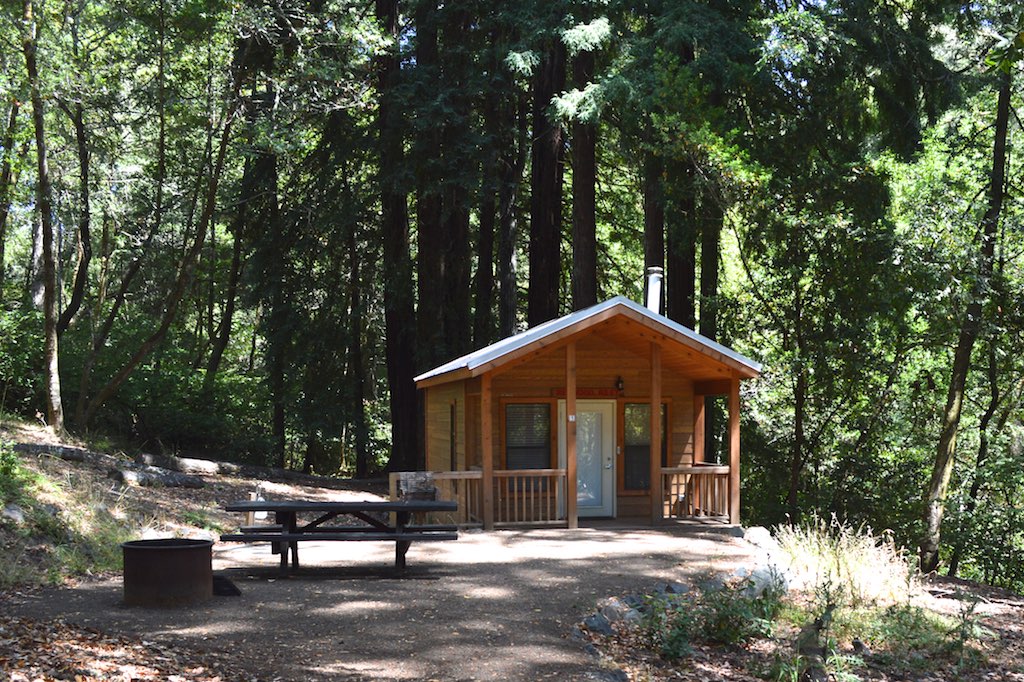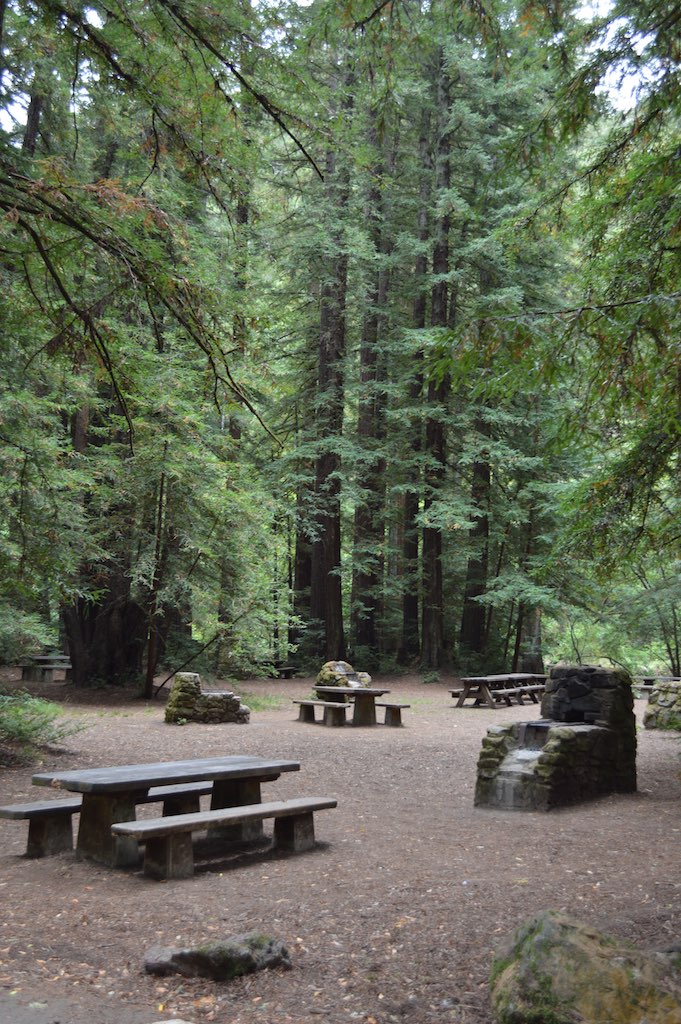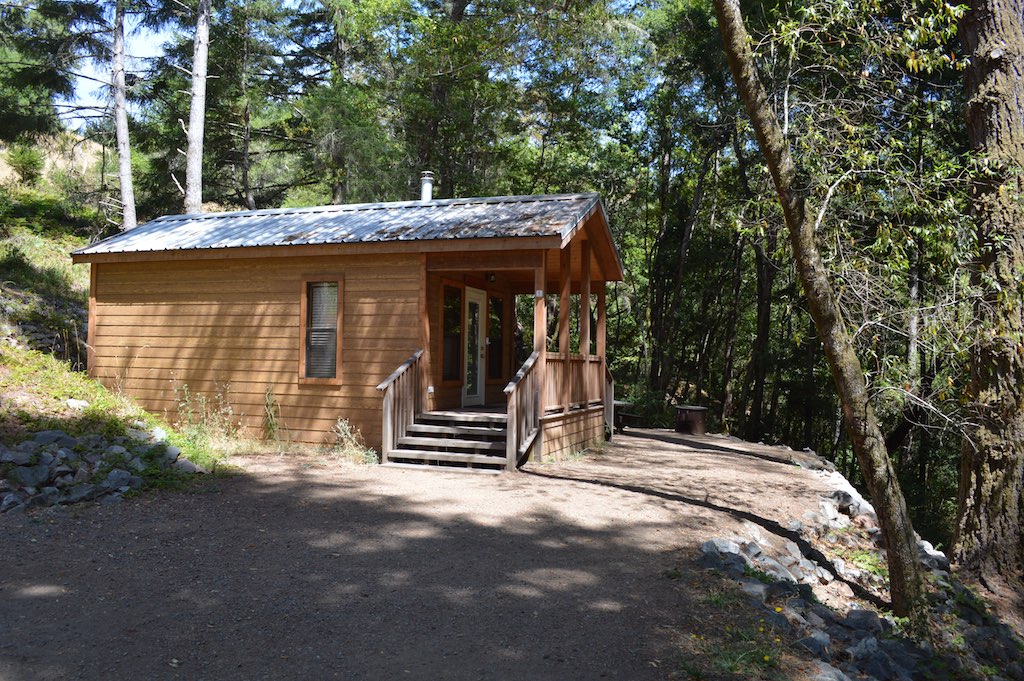CAMPING AND CABINS
Reservations can be made from six months to two days in advance. The reservation link's website will indicate if any campsites are not reserved for the current day by marking them with a “W” for walkup. Walkup sites are not sites you have to walk to, but rather are sites that may be available on a first-come, first-served basis.
Click here for cabin reservations!
Standard campsites and cabins have reservation fees, payable in advance. Options are
Creekside Loop—Reservable
Orchard Hill Loop—Reservable
Madrone Group Camp—Reservable
Madrone Cabins—Reservable
Hike & Bike—First-come, first-served, if you hike or pedal into the park—maximum 8 persons.
Devil’s Gulch Group Camp and Horse Camp—Reservable thru mid-August, then closed until the end of February.


 CAMPING DETAILS
CAMPING DETAILS
The main campground has about 60 single-family campsites with restrooms, hot showers, and piped drinking water. Some parking spaces can hold small trailers or RVs; none have hookups.
The Madrone Group Camp can be reserved for up to 50 people.
Devil’s Gulch has three campsites. Two tent-only sites can accommodate up to 10 people. The larger, equestrian-use-only campsite has a corral, hitching racks, and water troughs; it can accommodate up to 20 people and 12 horses. This site is restricted for use by equestrians; therefore, horses must be present every night.
Campgrounds are often full on weekends and every day during the summer months. The maximum occupancy for standard, single-family campsites is six persons of any age. All campsites have a picnic table, fire ring, and barbecue grill for charcoal.
Campers should leave food items in a closed vehicle to prevent theft by raccoons and other park wildlife. Food lockers are provided for convenience only and are not meant to be critter-proof. Hammocks, clotheslines, and other weight-bearing structures are not permitted to be hung from trees; all trees and plants are protected.
Check-in begins at 2 p.m. and checkout time is 12 noon. This park strictly adheres to these times. Be advised that if you arrive prior to check-in time you may be required to wait in the day use area (and pay any applicable use fees, depending on how early you arrive.)
Reservations can be made from seven months to two days in advance. The reservation link's website will indicate if any campsites are not reserved for the current day by marking them with a “W” for walkup. Walkup sites are not sites you have to walk to, but rather are sites that may be available on a first-come, first-served basis.
Note that sites 15, 21, 30, 37, 39, and 58 are only for visitors with disabilities. A valid DMV-issued handicapped placard/license plate with registration printout and photo ID are required at time of check-in to an accessible campsite. The visitor with the disability must be present each night/day of the reservation/use period.
 CABINS
CABINS
Four cozy cabins at Madrone may each be reserved for up to five people. One, “Coho Redd,” is reserved for people with disabilities.
Click here for cabin reservations!
Cabin Details
Each 12 x 20 square foot cabin has electric outlets, lighting, wood flooring, a covered porch, a small electric faux-wood-burning heater (not for cooking), and four platform bunk beds. Mattresses are not provided. Cabin occupancy is five persons maximum. Cabins have keyless doorknobs. At check-in, you will be provided with a cabin door code for entry. You will need to bring pots, pans, utensils, towels, flashlight, sleeping bags and/or sleeping pads. The cabins do not have bathrooms, but a separate restroom building with coin-operated hot showers is a short walk away.
Site Features
The Madrone area lies at the bottom of the grassy hills of Mount Barnabe. You'll enjoy the shade of the bay, oak, madrone, and redwood trees. Outside each cabin are a picnic table, fire ring, barbecue grill and water spigot. Parking is 100–300 feet away. You can load and unload belongings in closer short-term parking.
Cabin Rules
- Check-in time begins at 3:00 p.m. and check out is 11:00 a.m. These times are strictly adhered to. We cannot accommodate early check-in or late check-out requests.
- Parking for one licensed vehicle is included in the rental fee. One additional vehicle may be allowed for an additional extra vehicle fee $15 per night. No RVs, trailers or tents are permitted.
- Only charcoal briquets are permitted in the barbecue grills.
- Wood may be burned in the outdoor fire ring only. It can be purchased at the park.
- A maximum of five persons are allowed in each cabin at all times.
- Absolutely no open flames are permitted indoors, such as those from camp stoves, candles, or barbecues.
- Smoking in the cabin or within 30 feet of the buildings is prohibited by law. Violation will result in forfeiture of the cleaning deposit.
- Dogs and other pets are not allowed in or around the cabins. Please leave your pet at home.
